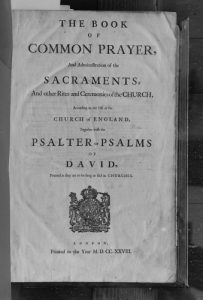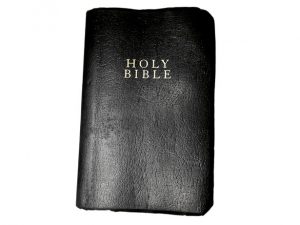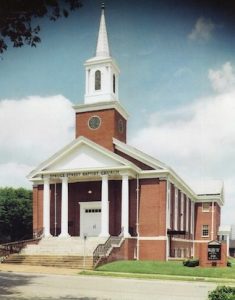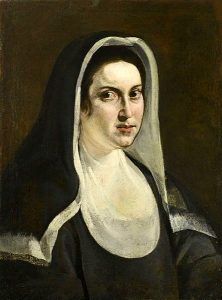Most Sundays, and in many contexts around the world on weekdays as well, Christian worshipers read, sing or chant portions of a Psalm, an entire Psalm or even several Psalms during a service. The standard collection of Psalms, the Psalter, found in the Hebrew Scriptures (Old Testament) portion of the Bible, is “an anthology of religious verse” and “the hymn book of the Second Temple” of Jerusalem (ca. 538 Before the Common Era [BCE] to 70 Common Era [CE]) (Litton vii).
Here we will take a look at the Psalms from three perspectives: the history of the Psalms; the different genres that comprise them; and the ways in which the Psalms are used in Christian settings, including the Gregorian chant (Plainsong) tones to which the Psalms are often set in those contexts. Learning more about the Psalms can be instructive on their own but might also point to options for enriching our lives and enhancing our spiritual growth.
A Short History of the Psalms
The Psalms – which number 150 in most traditions (151 in others) – have a complex history. Written in Hebrew within the context of the Israelites, they were almost certainly first transmitted orally – sung, actually – over six centuries prior to the Hellenistic era (ca. 313-31 BCE). However, not much can be said about the Psalms as musical compositions (nothing can be discerned about melody or orchestration), even though some Psalms are (incorrectly) designated “Psalms of David” (the King of Israel who had musical skills and lived around 1010 BCE). Scholars postulate that many Psalms were originally composed for liturgical performance in the Temple (Murphy, 626-29).
The Psalms, along with the rest of the Hebrew Scriptures, were translated into Greek in Alexandria, Egypt, in the third century BCE. This translation, known as the Septuagint, “was the primary form of the Bible for Hellenized Jewish communities and thus was that used by most early Christians” (Coogan, 687). That is, this Greek version of the Psalms and other sacred writings would have been used on a daily basis by Jesus and his Jewish followers.
 It was St. Jerome who started around 384 CE to translate the Greek Bible into Latin, beginning with the Psalms. After several years of labor, however, he concluded that the Hebrew Bible should be translated directly from the Hebrew texts. Jerome’s collection of the Biblical texts, along with translations of other books, into one volume probably occurred in the sixth century CE and is known as the Vulgate (from the Latin “vulgare,” “common version”) (“Vulgate,” 1451). In the 15th and 16th centuries, the Roman Catholic Church adopted a number of Vulgate versions of the Bible and used Latin in the liturgy. The so-called Clementine version of the Bible (1592) became the official authorized Latin version until the 20th century (“Vulgate,” 1452).
It was St. Jerome who started around 384 CE to translate the Greek Bible into Latin, beginning with the Psalms. After several years of labor, however, he concluded that the Hebrew Bible should be translated directly from the Hebrew texts. Jerome’s collection of the Biblical texts, along with translations of other books, into one volume probably occurred in the sixth century CE and is known as the Vulgate (from the Latin “vulgare,” “common version”) (“Vulgate,” 1451). In the 15th and 16th centuries, the Roman Catholic Church adopted a number of Vulgate versions of the Bible and used Latin in the liturgy. The so-called Clementine version of the Bible (1592) became the official authorized Latin version until the 20th century (“Vulgate,” 1452).
In the 16th century, the Protestant Reformation challenged the polity and practices of the Roman Catholic Church. In England and other countries, the Bible began to be translated into the common languages of the people. One of the earliest translators of biblical texts into English was William Tyndale, who made the translations directly from Greek and Hebrew. His efforts and some of his other theological writings led to his imprisonment, strangulation and being burned at the stake in 1536 (“Tyndale,” 1400).
In the Anglican tradition, the Psalms have been included in every prayer book between 1549 and 1938; the Psalms in these books were based on a translation of the Bible by Miles Coverdale, who translated the Psalms in 1535. Coverdale’s version of the Psalms was not based on the original Hebrew, but rather through both Greek and Latin translations. In order to be truer to the original meaning in such formats as the 1979 Book of Common Prayer (BCP) of the Episcopal Church, the language of the Psalms has been updated through scholarly examination of the Hebrew in the (Litton, vii).
An Overview of the Psalm Genres
An examination of the genres into which the Psalms fall is helpful because it shows the range of emotions, occasions and settings that they reflect – even centuries after they were first recited, performed and used liturgically. Scholars are not agreed on the genres or always on which Psalms fit into which genre, but we can outline some basics.
The main genres reflected in the Psalms are hymns, thanksgiving Psalms, laments, royal Psalms, wisdom Psalms, and liturgies (Murphy, 627-29).
Hymns, generally speaking, are songs of praise that usually begin joyfully. The author summons oneself or the community to praise God. God is praised because he has done great things such as creating the world. Examples of hymns include Psalms 46, 48, 103 and 117 (Murphy, 627).
Thanksgiving Psalms, such as 18, 30, and 116, begin like a hymn or song of praise but then shift to giving thanks to God for deliverance from some kind of distress (Murphy, 627).
Laments. The most common type of lament Psalm is individualistic (approximately 40 Psalms); lament Psalms can also be collective.  The lament Psalms begin with a cry for help to the Lord, followed by the specific distress in question: sin, illness, death, false accusation, persecution of an enemy. Interestingly, “In most cases one cannot pinpoint the precise reason for the complaint.” This feature makes lament Psalms particularly resonant with modern readers. Psalm 22, for instance, the first verse of which is familiar to Christians as Jesus’ agonized cry from the cross – “My God, my God, why hast Thou forsaken me?” – goes on to wail that others despise the psalmist, that wild animals are prepared to devour him, and that all of his bones are out of joint. While the threats to the ancient person are not the same as threats to us in our day, the modern reader can certainly relate to the stresses and challenges cited (Murphy, 627-28). (Importantly, Psalm 22, like other lament Psalms, ends with the comforting affirmation that God is in control.)
The lament Psalms begin with a cry for help to the Lord, followed by the specific distress in question: sin, illness, death, false accusation, persecution of an enemy. Interestingly, “In most cases one cannot pinpoint the precise reason for the complaint.” This feature makes lament Psalms particularly resonant with modern readers. Psalm 22, for instance, the first verse of which is familiar to Christians as Jesus’ agonized cry from the cross – “My God, my God, why hast Thou forsaken me?” – goes on to wail that others despise the psalmist, that wild animals are prepared to devour him, and that all of his bones are out of joint. While the threats to the ancient person are not the same as threats to us in our day, the modern reader can certainly relate to the stresses and challenges cited (Murphy, 627-28). (Importantly, Psalm 22, like other lament Psalms, ends with the comforting affirmation that God is in control.)
An example of a collective lament Psalm is 79, which reflects the reality of the destruction of Jerusalem (Murphy, 628).
Royal Psalms generally reflect the reality of the current rulership, not a condition in the future (e.g., predictive). Some royal Psalms were related to a coronation or anniversary, military operations, or a royal wedding. The Israelite monarchy had mostly disappeared by the time of these Psalms, but the concept appears to have been reinterpreted to apply to the hope of the promised Messiah (Murphy, 628).
Wisdom Psalms. This is probably the most vague of the classifications. Scholars assert that some Psalms – such as 1, 34, 73 – have been influenced by the wisdom literary tradition (Murphy, 628).
Liturgies. The word “liturgy,” from the Greek “leitourgia,” meaning a public work done for or on behalf of the people, could be said to characterize most of the Psalms. But several have more liturgically-specific attributes. Psalm 136 – which contains the phrase “for his lovingkindness is everlasting” in every verse – is in the form of a litany (Murphy, 628), where a cantor might recite the first half of the verse with the congregation repeating the “refrain” half.
The genres of the Psalms show their distinctive nature and why the psalter is one of the most treasured books of both Jews and Christians. “The familiarity and the frankness of the lament, the enthusiasm of the hymn, the confessional character of the thanksgiving – all these characteristics speak to the human heart before God” (Murphy 629).
The Liturgy, Chant Tones and Ways of Singing the Psalms
 Psalms have been sung during the Eucharist service (Mass) in the Christian tradition since at least the 4th century (Litton, vii). They were then incorporated into the “daily offices” of the Anglican and Episcopal traditions – Morning Prayer, Noonday Prayer, Evening Prayer, and Compline – and the Liturgy of the Hours in the Roman Catholic tradition. In these contexts, the Psalms are sung, read or chanted individually or in churches, convents or monasteries in a prescribed liturgical cycle – several times a day, most days – which means that all 150 Psalms are encountered during that cycle (within weeks, months, or the entire year).
Psalms have been sung during the Eucharist service (Mass) in the Christian tradition since at least the 4th century (Litton, vii). They were then incorporated into the “daily offices” of the Anglican and Episcopal traditions – Morning Prayer, Noonday Prayer, Evening Prayer, and Compline – and the Liturgy of the Hours in the Roman Catholic tradition. In these contexts, the Psalms are sung, read or chanted individually or in churches, convents or monasteries in a prescribed liturgical cycle – several times a day, most days – which means that all 150 Psalms are encountered during that cycle (within weeks, months, or the entire year).
Because they have been so popular and foundational in Christian tradition, the Psalms have been adapted to music in many ways. In addition to Plainsong or Gregorian chant, which we will discuss in detail below, Psalms have been set in other ways:
- Anglican Chant, adapted from Plainsong; the congregation sings in four-part harmony.
- Simplified Anglican Chant, “notated as four measures of music with two sets of notes each. Each measure equals one half-verse of Psalm text. Thus one full line of Simplified Anglican Chant equals two verses in the text of the Psalm.
- Hymns. Many composers and arrangers have written hymns based on Psalm texts. In the Hymnal 1982 of the Episcopal Church, a paraphrase of Psalm 23 (“the Lord is my shepherd,” often heard at funerals) is set to the Irish melody, St. Columba, in hymn 645. A paraphrase of Psalm 84 is set to the tune called Brother James’ Air in hymn 517, “How lovely is thy dwelling-place.”
- Spirituals/Negro Spirituals. In hymn 65 from the 1993 hymnal, Lift Every Voice and Sing II, Psalm 100:1, “Bless the Lord, O my soul,” is set to music by Andrae Crouch.
- Anthems. Composers have used the Psalms to create inspiring and memorable anthems for choirs. Two examples by Drury University Professor Carlyle Sharpe are Psalms 67 (“God be gracious to us and bless us”) and 122 (“I was glad when they said unto me”). Psalm 122 was also set by English composer Charles Hubert Hastings Parry for the coronation of King George V. Famed composer Georg Friedrich Händel set Psalm 112 to his anthem Laudate pueri when he was 22 years old. Another Händel anthem is Nisi Dominus based on Psalm 127. A number of composers have set Psalm 121 – “I lift up my eyes to the hills” – to music for choirs.
In the Anglican and Episcopal contexts, the chant tones to which the Psalms are set – called Plainsong or Gregorian Chant – aid in the words’ ability to sink into one’s soul.  There are eight main Psalm tones plus the Tonus Peregrinus (meaning “wandering” or “traveling”). One of these, Tone 2, is recognizable from the nuns who sing at the start of the beloved movie, The Sound of Music. (The chant tones can be found through an online search using the key words “Gregorian chant tones.”)
There are eight main Psalm tones plus the Tonus Peregrinus (meaning “wandering” or “traveling”). One of these, Tone 2, is recognizable from the nuns who sing at the start of the beloved movie, The Sound of Music. (The chant tones can be found through an online search using the key words “Gregorian chant tones.”)
To avoid monotony in church, convent or monastery settings, Psalms may be chanted in different ways (Litton, ix):
- Direct recitation. The whole Psalm or a portion of one is chanted or read together by the congregation.
- Antiphonal singing: verse-by-verse alternation between groups, such as the choir and congregation.
- Responsorial singing. A cantor or the choir might sing a verse with the congregation singing a refrain or antiphon in between verses. (An antiphon is a short sentence used as a refrain, often taken from the Psalm being sung or chanted.)
Monks and nuns frequently read or chant antiphonally with “a distinct pause at the asterisk,” which usually occurs in the middle of a Psalm. Thus, when chanting or reading a Psalm and pausing at the asterisk – slowly, quietly, contemplatively – one has a chance to meditate ever so slightly on that line before going on to the next. The meaning starts to sink into one’s soul. (People seeking this kind of liturgical experience can visit any number of convents and monasteries in the US and around the world for varying amounts of time and varying costs.)
 It is often verses from the Psalms that are found (without attribution) in the various liturgies – Eucharist, the Daily Office services, the burial service and special services throughout the year. In some services, entire Psalms are found explicitly; on Ash Wednesday, for instance, Psalm 51 (BCP, 266), a lament, is often chanted while ashes are placed by the priest on congregants’ foreheads. Four Psalms – 4, 31, 91 and 134 – are used in Compline (BCP, 128ff), although the officiant (who is often a layperson) has the option of omitting one or more.
It is often verses from the Psalms that are found (without attribution) in the various liturgies – Eucharist, the Daily Office services, the burial service and special services throughout the year. In some services, entire Psalms are found explicitly; on Ash Wednesday, for instance, Psalm 51 (BCP, 266), a lament, is often chanted while ashes are placed by the priest on congregants’ foreheads. Four Psalms – 4, 31, 91 and 134 – are used in Compline (BCP, 128ff), although the officiant (who is often a layperson) has the option of omitting one or more.
- The Suffrages (petitions) from Morning Prayer II (Form A, BCP, 97) start with “Show us your mercy, O Lord; and grant us your salvation.” This is from Psalm 85:7.
- Form A of the Morning Prayer Suffrages also contains the plea, taken from Psalm 67:2, “Let your way be known upon earth, your saving health among all nations.”
- Noonday Prayer (BCP, 103), Evening Prayer (BCP, 117) and Compline (BCP, 128) all contain a bidding paraphrased from Psalm 70:1: “O God, make speed to save us. O Lord, make haste to help us.”
- Compline states this assurance (BCP, 132): “Into your hands, O Lord, I commend my spirit. For you have redeemed me, O Lord, O God of truth.” While this may resonate with Christians familiar with Jesus’ cry from the cross (Gospel of Luke 23:46: “Into your hands I commit/commend my spirit”), Jesus is almost certainly quoting Psalm 31:5.
Encountering the Psalms is a rich and multi-layered way into the Jewish roots of the Christian faith and a reminder of our solidarity with and indebtedness to our ancestors. Jesus and his Jewish contemporaries probably knew the Psalms by heart and took great comfort and strength from them. Psalm texts run the gamut from our deep despair and fear to the heights of joy and intimacy with the Divine. Reciting the Psalms on a regular basis – especially through chant – can greatly enrich our spiritual lives.
Resources
Coogan, Michael D. “Septuagint,” in Bruce M. Metzger and Michael D. Coogan, eds. Oxford Companion to the Bible, 686-87. New York and Oxford: Oxford University Press, 1993.
Hempel, Johannes. “Psalms, Book of,” in George Arthur Buttrick, Dictionary Editor, The Interpreter’s Dictionary of the Bible: An Illustrated Encyclopedia, Vol. 3, 942-58. Nashville and New York: Abingdon Press, 1962.
Litton, James, ed. The Plainsong Psalter. New York: Church Publishing Incorporated, 1988.
McGowan, Andrew. Ancient Christian Worship: Early Church Practices in Social, Historical, and Theological Perspective. Grand Rapids: Baker Academic, 2014.
Murphy, Roland E., O. Carm. “Psalms, The Book of,” in Bruce M. Metzger and Michael D. Coogan, eds., Oxford Companion to the Bible, 626-29. New York and Oxford: Oxford University Press, 1993.
“Tyndale, William” in F.L. Cross and E.A. Livingstone, eds., The Oxford Dictionary of the Christian Church, Third Edition, 1400-01. Oxford: Oxford University Press, 1997.
“Vulgate,” in F.L. Cross and E.A. Livingstone, eds., The Oxford Dictionary of the Christian Church, Third Edition, 1451-52. Oxford: Oxford University Press, 1997.
